So, what is pistachio paste? Also known as pistachio butter or pistachio spread, it is pistachios ground down until spreadable and it can technically be made with just one ingredient – pistachios.
- Nutty and lightly sweet, it’s just pistachios in paste form.
- Such an easy recipe.
- Just 3 ingredients.
- A gorgeous, vibrant green with no food colouring.
Pistachio paste is perfect for spreading on toast or inside macarons and cookies. It’s great for mixing into buttercream and cream cheese too and adds amazing natural pistachio flavour. It’s a wonderful treat for gifting too.
Commercial pistachio paste is often much runnier than this homemade version but the wonderful thing about making it at home is you can determine the consistency you want. Both versions use the same ingredients and the consistency comes down to how long you process it.
Try this homemade almond paste too.
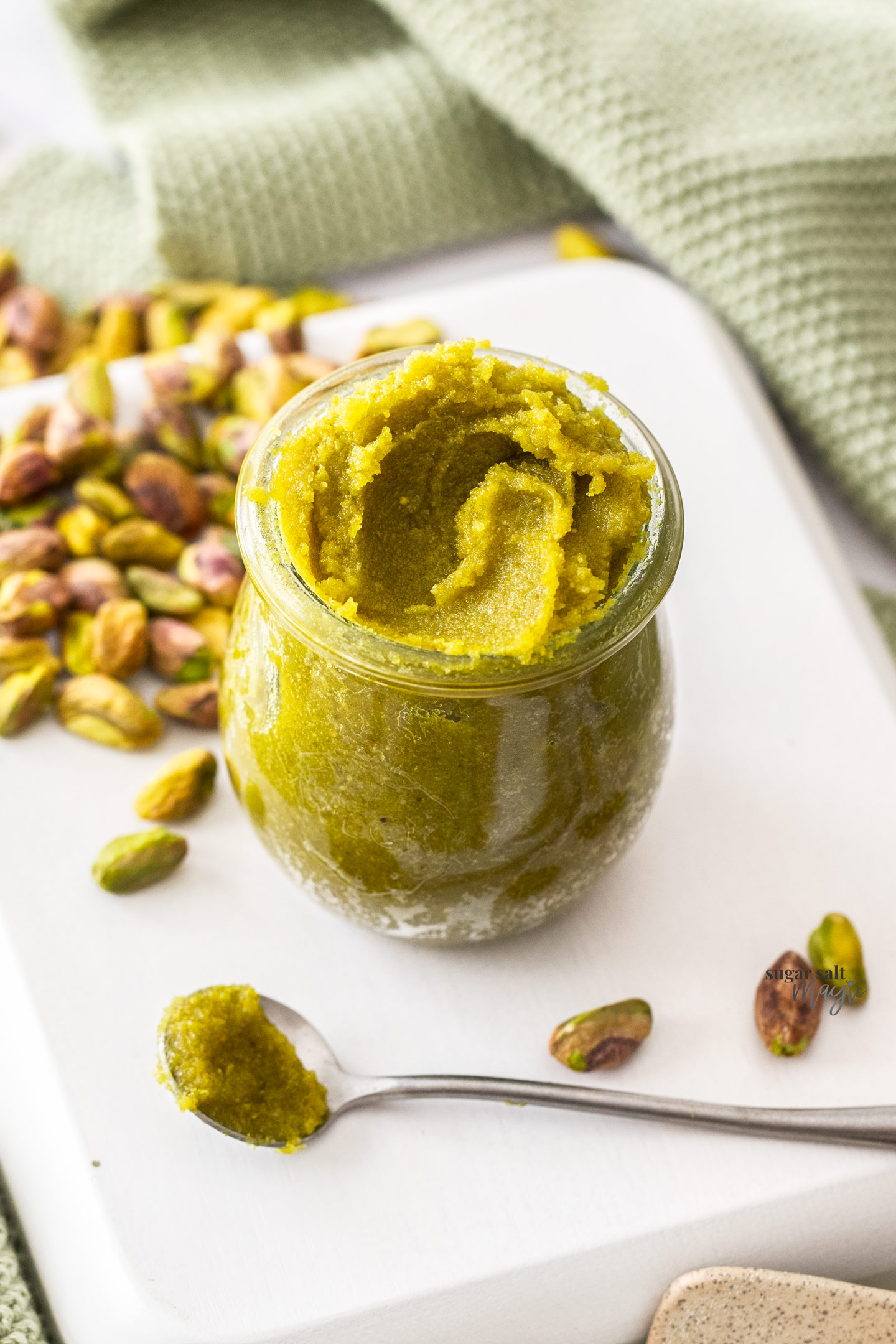
Never Miss a Recipe!
Get the latest recipes straight to your inbox!
Ingredients you’ll need
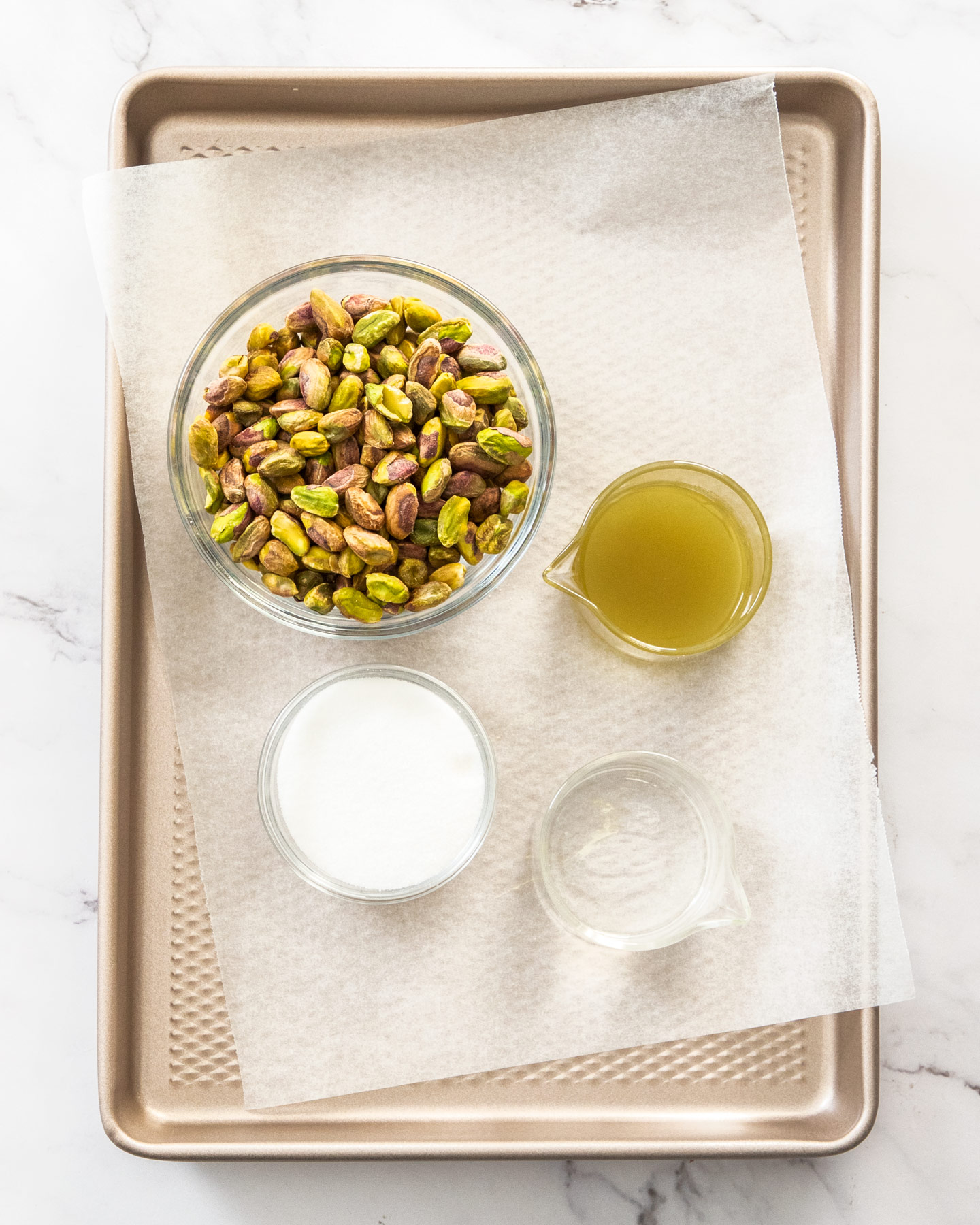
Detailed quantities and instructions in the recipe card below.
There are very few ingredients in pure pistachio paste. You could just make it with nothing more than raw shelled pistachios and a little patience. I add a little sugar to sweeten (which you can leave out) and a little oil to help the processing along and the texture.
You can adjust the sweetness to your taste and even use other types of sweetener. A little honey will add sweetness plus even more minerals and antioxidants to the already healthy pistachios.
What type of pistachios to use?
You want raw pistachios for this. You can use shelled or unshelled pistachios but you’ll need the shells removed to turn it into paste. Don’t use salted as it will be a far too salty result but feel free to add a pinch or two of salt as your making this. You can also use toasted pistachios but the paste will be more brown in colour.
How to make pistachio paste (step-by-step)
One thing you’ll need to make pistachio paste at home is a reliable food processor and the better the processor, the quicker it’ll turn into paste.
If you’re using an older or less powerful processor, you may just need to stop and let the food processor cool. A more powerful food processor will make the job quicker and will also make a smoother paste.
Detailed quantities and instructions in the recipe card below.
Remove the skins
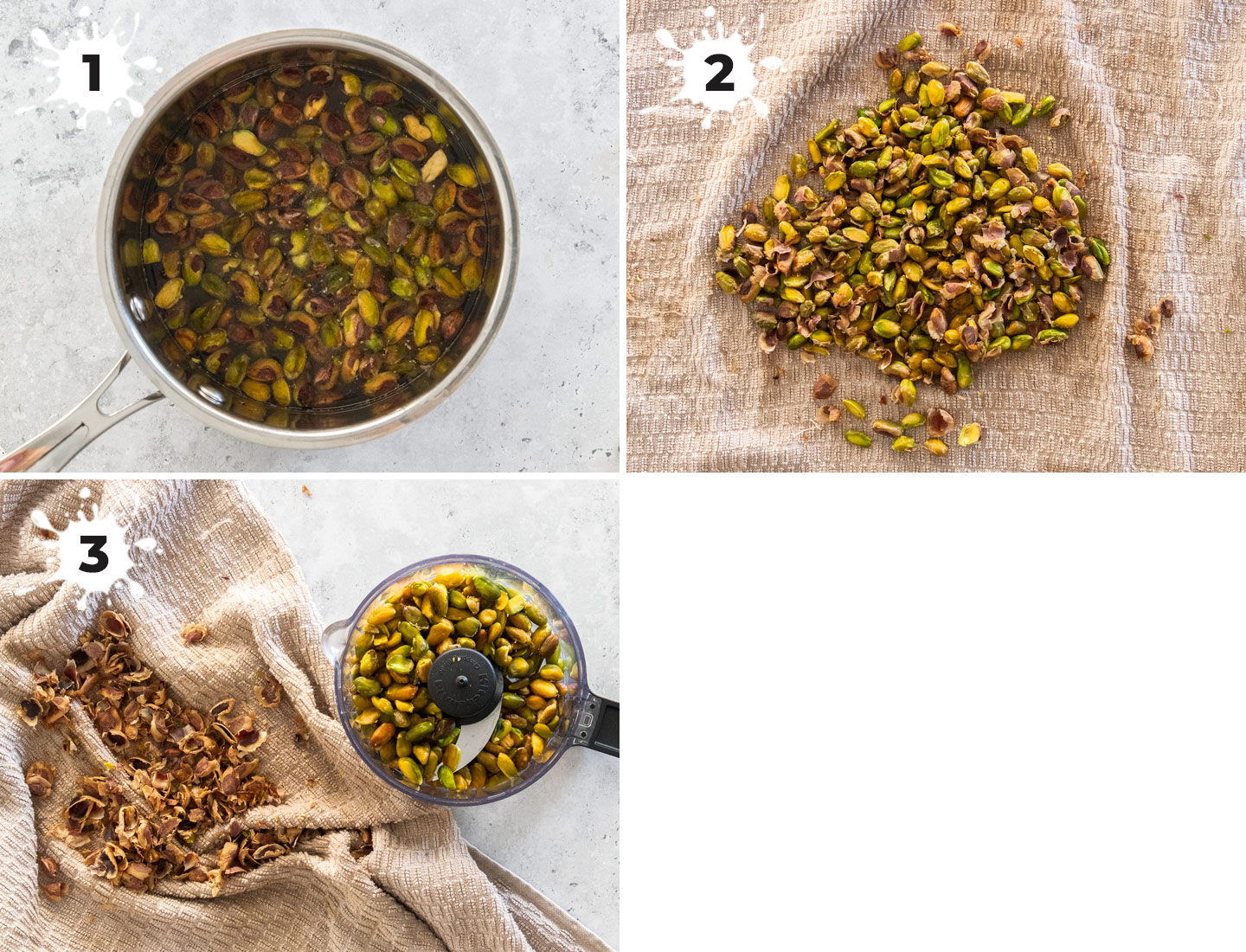
The first step is removing the skins.
- Bring some pistachios in water (photo 1) to a boil and blanch for 90 seconds.
- Drain the pistachios and drop them onto a clean tea towel (photo 2).
- Wrap them up and give them a good rub to loosen the skins.
- Unwrap and many of the skins will have just fallen off, but you may need to rub at a few. Separate the skins from the nuts (photo 3).
Process the pistachios
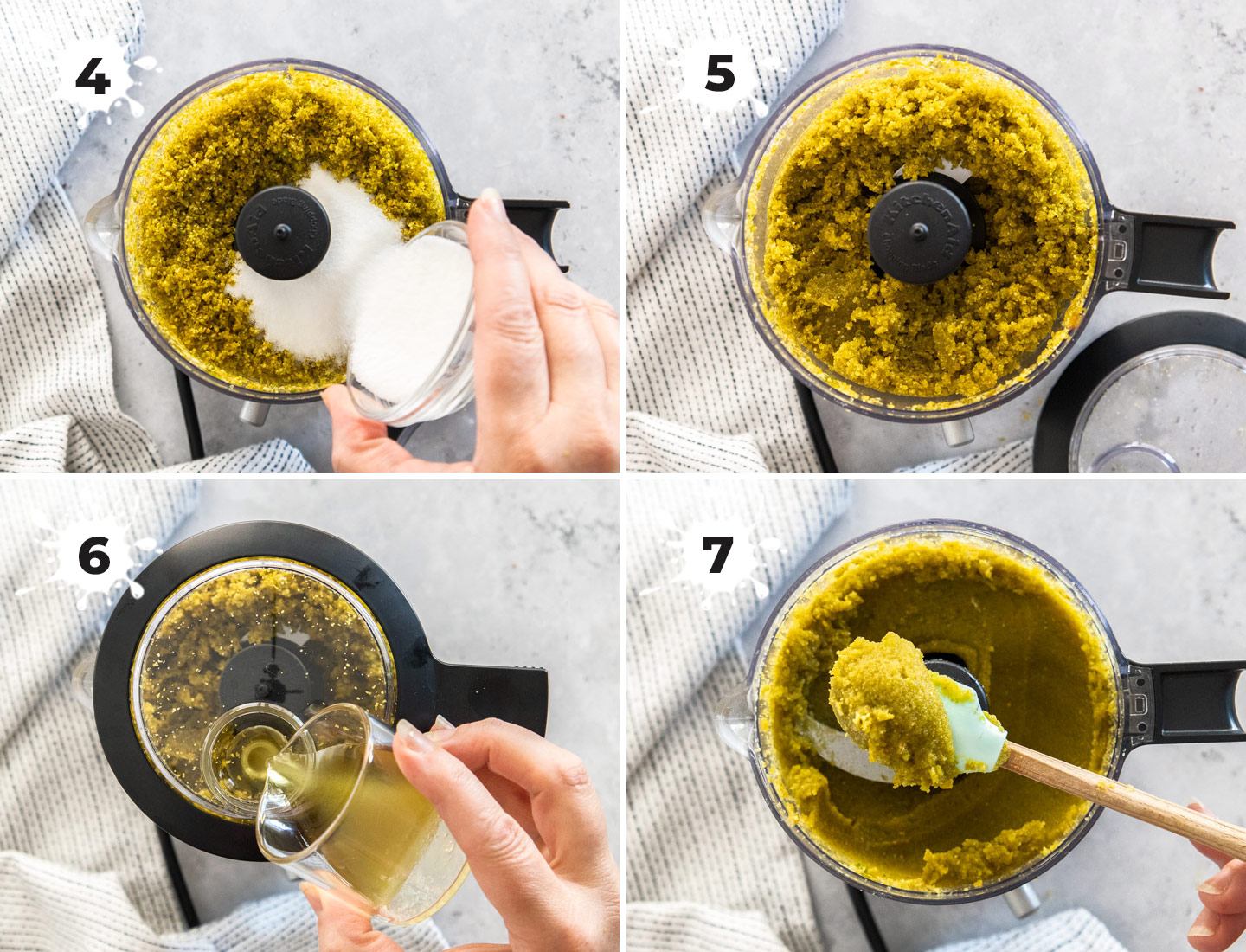
- Place the nuts into a food processor and process until they look powdery.
- Add the sugar (photo 4) and process until it begins looking pastey in parts (photo 5).
- Add the oil (photo 6) and water, if using, very slowly with the processor running.
- Now continue blending until you have a thick, almost smooth paste (photo 7) or keep going until it becomes extra smooth.
Texture and consistency
The consistency and texture of homemade pistachio paste are purely up to you. It can be smooth and even slightly runny or it can be a little grainier and much thicker.
A powerful food processor will do a better and quicker job of making it smooth and the longer you process, the smoother and thinner it will become. The paste shown in these pictures was processed for about 6 minutes in my KitchenAid mini food chopper and isn’t completely smooth.
While the paste is still fresh and warmed from the food processor it will be slightly softer than after it has cooled. As it cools, it firms up a little softer than marzipan. Homemade pistachio paste will darken as it cools.
Tips and tricks
- It takes time: Be patient. Making pistachio paste does take 10-15 minutes and will depend on how powerful your food processor is.
- Take breaks: You don’t want to burn out your processor so give it a break every now and then to let the motor cool.
- Don’t skip blanching: Blanching the pistachios in boiling water is vital. It not only makes it easier to remove the skins, it also softens the nuts a little making it easier on your processor.
- Processor not blender: I find blenders in any form just don’t work (I tested the 3 variants I have), it must be a food processor.
- Don’t leave the skins on: While the skins are edible, they will make it much harder to get a smooth paste and your paste will be brown instead of green.
- Use fresh pistachios: When I say fresh pistachios, I mean a fresh pack, not the ones that have been sitting in the pantry for a while as their flavour will be more stale.
- Add some flavour: You can add some lemon zest, orange blossom water, a little rose water or vanilla for some variations in flavour.
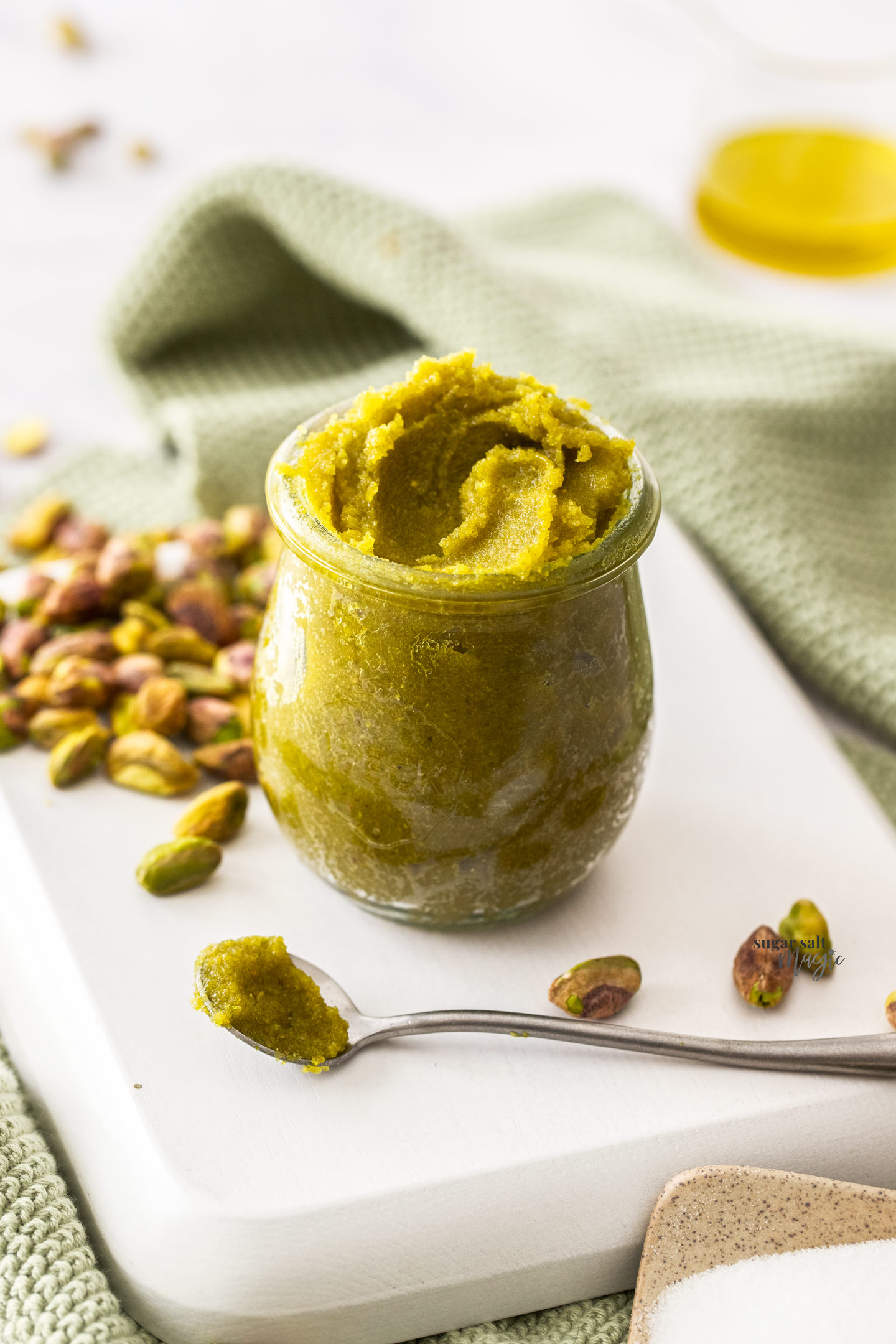
What do you use pistachio paste for?
Pistachio paste / pistachio butter can be used as it is as a spread on bread or toast. It can also be used anywhere you would use almond paste, in desserts like frangipane or inside croissants. It’s also great mixed through buttercream, pastry cream or whipped cream.
Try mixing it through ice cream to make pistachio ice cream or blend it into cake batter for a gorgeous pistachio cake.
FAQs
Commercially prepared pistachio paste has more of runny texture (almost honey-like) while pistachio butter is more like a thicker spread. In home cooking, the terms pistachio paste and pistachio butter are more interchangeable since the texture and consistency are in the control of the maker.
Pistachio paste has the buttery and nutty flavour of pistachios. Adding sugar or a touch or salt is optional and using either flavourless oil or pistachio oil means you get pure pistachio flavour.
Pistachio paste will keep at room temperature for a week or in the refrigerator for up to a month.
Storage
Homemade pistachio butter can be kept in an airtight container at room temperature for around a week or in the fridge for up to a month. It can also be frozen for up to 3 months.
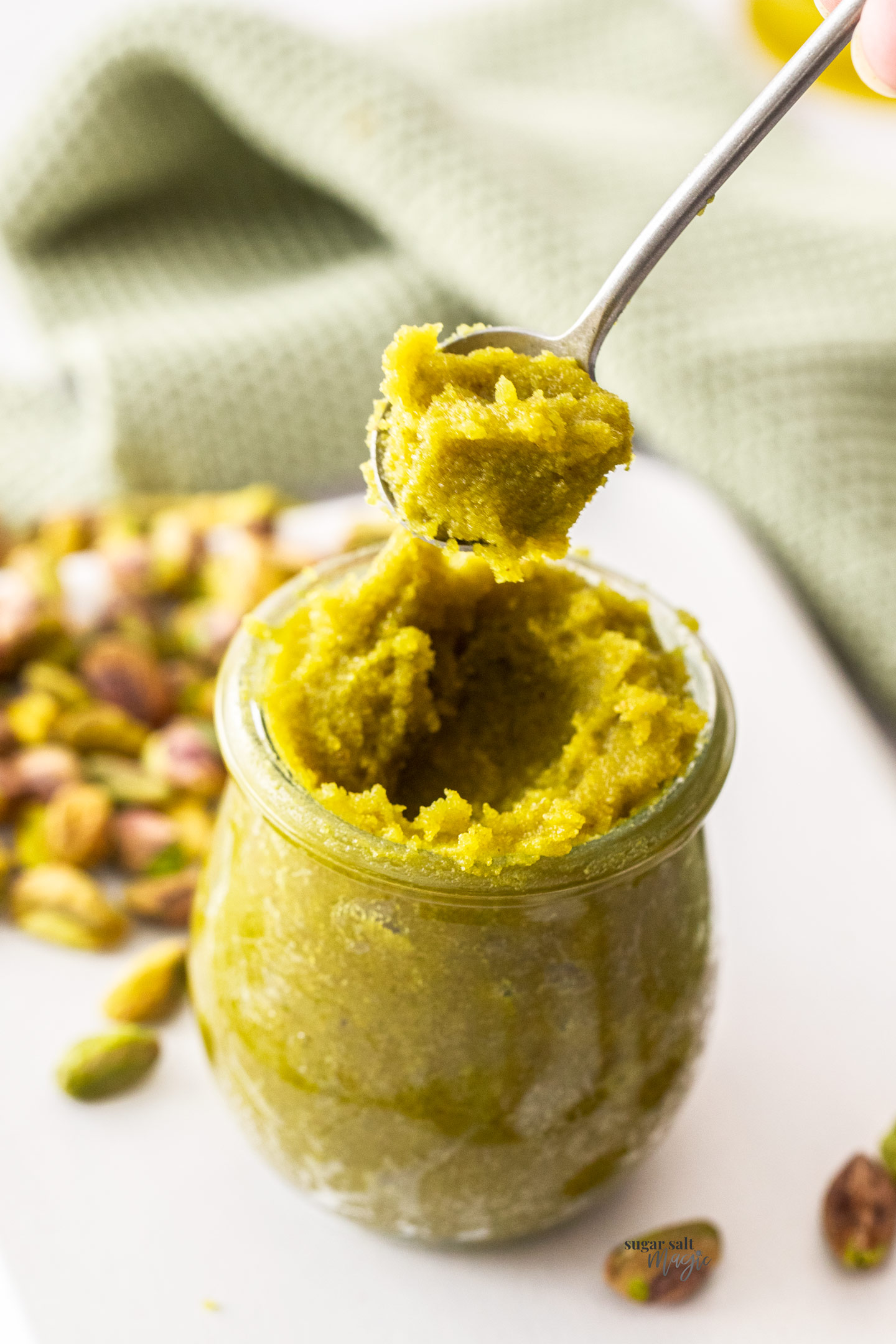
Did you try this easy homemade pistachio paste recipe?
Leaving a rating and comment below the recipe is so helpful!
Hungry for more? Subscribe to the newsletter for free recipes straight to your inbox. Also, follow along on Facebook, Pinterest and Instagram.
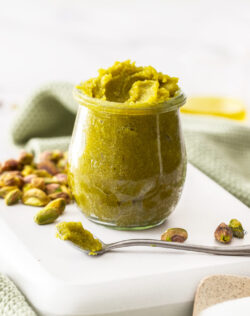
Ingredients
- 1 cup shelled unsalted pistachios (140g)
- 2 tablespoons white granulated sugar
- 1 ½ tablespoons pistachio oil avocado oil or other neutral-flavoured oil
- 1 ½ tablespoon water
For best results, always weigh ingredients where a weight is provided
Instructions
- Place pistachios in a small saucepan and add 1 cup of water.
- Over medium heat, bring to a boil for 1 minute.
- Drain through a strainer then drop them onto a clean kitchen towel. Fold it up and rub vigorously.
- Peel away the papery brown skin from the pistachios and discard – this process will take about 10-15 minutes.
- Transfer the peeled pistachios to a food processor and process for 2 minutes until very fine and almost fluffy looking. Different food processors will affect how long the blending takes as will how old or fresh your pistachios are.
- Add the sugar and blend a little longer until it starts becoming a very thick paste.
- With the processor running dribble in the oil slowly, followed by the water. Continue processing until it becomes smooth (or the consistency you like). This can take up to 15 minutes with some processors, so give it a break every so often so you don’t burn out the motor.
- The paste will be a little warm from the processor and will thicken as it cools. It will start out a vibrant green colour and darken as it cools.
- Please take a moment to leave a comment & rating. It's appreciated and so helpful.
Notes
- Makes about ¾ cup. Nutritional info is approximate and based on a 1 tablespoon serving.
- Tablespoons: I use a standard Australian 20ml tablespoon (equal to 4 teaspoons). Check yours before measuring.
- Will keep for up to 1 month in the fridge or 1 week at room temperature. Can be frozen for up to 3 months.
This post may contain affiliate links that earn me a small commission for my referral, at no extra cost to you. Thank you for supporting Sugar Salt Magic.

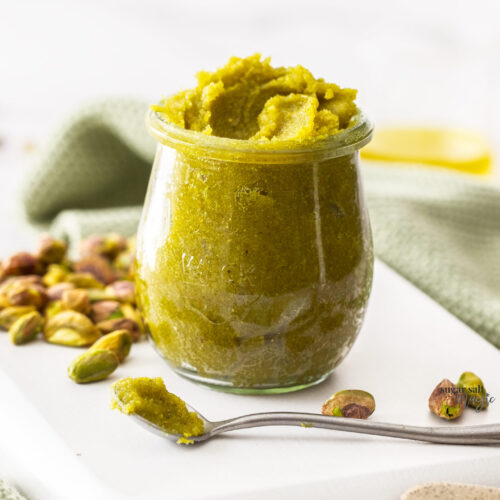
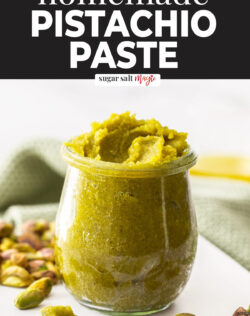
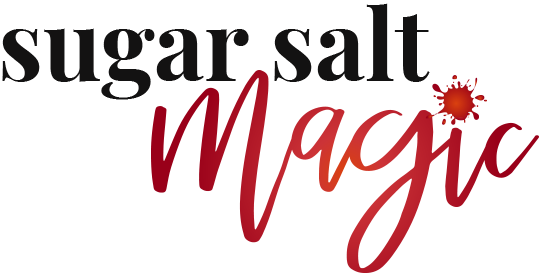
2 Comments on “Pistachio Paste”
Thank you Marie. I love these pastes and preserves to add to my recipe collection. They are so handy.
They really are. Hope you love this one, Pamela.